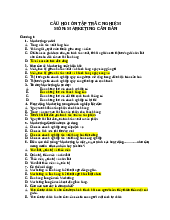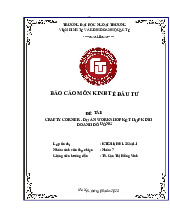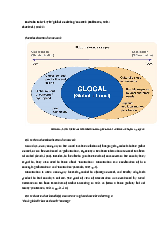
lOMoARcPSD|44862240
OMoARcPSD|44862240
Marketing Management
Fall Term 2018
Uniqlo’s Marketing Plan to Expand to Vietnam
Submitted by:
Group E
Kusu, Kentaro 2B8601
Dangol, Pabitra 2B8007
Andriani, Katherina 2B8202
Surbano, Elaine 2B8210
Trang, Vu Thu 2B8047
Al Yakob, Mohannad 2B7001
Submitted on:
December 9, 2018

lOMoARcPSD|44862240
Submitted to:
Prof. Alessandro Comai
Table of Contents and People In Charge
Report Section People In Charge
Abstract Katherina
Market Overview Elaine
Uniqlo
● Company Overview
● Organizational Vision, Mission, Competitive Strategy, Global Competition ●
SWOT Analysis
● Marketing Plan Objectives
Elaine
Elaine
Elaine
Elaine
Vietnam Market
● Demographics and Other Economic Indicators (e.g. Population, GDP,
Competitors, etc.)
● Market Overview
● Market Segments
● Competitive Landscape
Trang / Kentaro
Marketing Plan
● Strategy
● Products/Services
● Price
● Place – (Distribution)
● Promotion
Mohannad / Pabitra
Mohannad
Mohannad
Mohannad
Elaine
Marketing Communication Mohannad
Finance Katherina
Implementation
Recommendation / Conclusion
Pabitra
Pabitra

lOMoARcPSD|44862240
Abstract
Being the world’s third largest manufacturer and retailer of private label apparel that offers high-quality and
reasonably priced clothing, Uniqlo is preparing to increase its presence in the Southeast Asian and Oceania
market. The company has a goal of doubling its stores to around 400 stores by 2022 (Inside Retail Asia,
2017). After successfully opening stores in several countries in Southeast Asia, Uniqlo’s next move is to
penetrate Vietnam’s retail market by 2019, since Vietnam’s economic outlook proves to be a viable choice for
Uniqlo to invest in. Vietnam is chosen as the target market because of its good relationship with Japan; one of
its biggest investors, high density of population, stable political condition, and inexpensive labor but good
quality production. Moreover, in the recent years, Vietnam’s economy has increased significantly, which
resulted in the increase of customer’s demand, especially for the fashion industry.
Our main marketing objective is to open two first retail stores in Ho Chi Minh and Hanoi, two big cities in
Vietnam. Our main target customers are the middle income class, mainly the young generation. Currently
there are four main competitors in the market. For local brands, there are Canifa and Viettien, and for global
brands, there are Zara and H&M. Based on the perceptual map, Uniqlo is currently the leader of the functional
casual clothing brand, with price as affordable as the local brands. Our marketing strategy is based on the
marketing mix, which includes product, price, place, and promotion. We will differentiate our products by
providing functional products for different uses and special designs tailored for Vietnam customers,
introducing our special service in the stores, and establishing online store with direct shipping to customer’s
location. We will use three strategy methods for the affordable pricing; first, targeting price resulted from our
economy of scale from our factories and suppliers in Vietnam and from experience curve; second, reducing
total supply chain cost; and third; mark-up pricing. For the place strategy, we are planning to open our stores
at Vincom Mall, Hanoi, and Saigon Center, Ho Chi Minh. We will also launch a bilingual online store with
the English and Vietnamese languages. We are planning to do our promotion by advertising in media like TV,
radio, magazine, and billboards; distributing discount coupons; doing digital advertising like search engine
optimization and social media marketing; and collaborating with other brands.
With the 15% revenue growth each year, we estimated that we will reach break-even point and net income in
our second year of operation. Our marketing budget is estimated to $3,696,250 and will be realized in the 3
years, with marketing programs focused on promotional coupons, search engine advertising, billboards, brand
ambassador, magazine and newspaper advertising, television and radio, flyers and posters, website, and

lOMoARcPSD|44862240
others. We also developed contingency plans to mitigate any risk during the execution of the marketing plan
within limited budget, time, and available resources.
Global Fast Fashion Market Overview
In today’s current retail arena, fast fashion is the answer to the consumers’ unsatiated demand to avail of
modern clothing at a reasonable price. In the battle to dominate the market, global retail firms must have a
defined competitive advantage and strategy, differentiated products, as well as strong supply chain operations
(Anwar, 2017). These companies’ quick responses to the latest retail trends, together with an efficient
production and distribution system enable big retail market players to proceed with an easier
internationalization to expand their operations to different countries.
One successful example of a company’s quick response to consumer behavior and market trends is Uniqlo, a
Japanese fashion brand who is a global leader in clothing manufacturing and retailing of clothes, which is
under the Fast Retailing conglomerate.
Uniqlo Company Overview
Fast Retailing is a global company operating multiple fashion brands, including Uniqlo, the world’s third
largest manufacturer and retailer of private label apparel, Uniqlo offers high-quality and reasonably priced
clothing by managing all supply chain process through 18 countries. Fast retailing mission is to provide
ultimate-comfort life wear that enriches people's lives.
History
Tadashi Yanai, the founder and CEO of Uniqlo, grew up in the retail clothing industry. He was born in 1949
to a suit shop owner in Yamaguchi, Japan, and eventually became the president of his father’s chain of 22
stores in 1984. When he took over the presidency, he opened a store in Hiroshima called “Unique Clothing
Warehouse”, which was later shortened to "Uniqlo". At its start, Uniqlo was a typical multi-brand shop
carrying Nike, Adidas, and other foreign brands. “The Great Recession” of Japan in the ‘90s provided Uniqlo
with a great opportunity to grow rapidly. Uniqlo products quickly gained popularity among price conscious
Japanese customers, and by 1998, Uniqlo had expanded to 300 stores across Japan.

lOMoARcPSD|44862240
Fast Financial Facts
Financial Indicator Amount
2017 Total Revenue 1.86 Trillion Yen
Earnings Per Share 1,169.7 Yen
Return on Equity 18.3%
Operational Profit 176.4 Billion Yen
Uniqlo International: In 2001, Uniqlo opened its first store overseas in UK, London, followed by 3 stores in
USA which opened in 2005 but were closed in 2006, forcing Uniqlo to rethinking in its international business
strategy to expand outside of Japan. Because of the restrategising done by management, the current
performance of Uniqlo International has been going in an upward trajectory since 2007, as illustrated in the
revenue comparison figure below. While Uniqlo International was catching up to the revenue of Uniqlo Japan
in 207, this 2018, the combined revenues of Uniqlo International in different countries is expected to surpass
the revenues of Uniqlo Japan. This is aligned with the company’s long-term strategy in continuing to expand
its operations, both in brick-and-mortar retail stores, as well as increasing its network of partner factories to
broaden the reach of Uniqlo’s products.
Source: Uniqlo Annual Report (2017)

lOMoARcPSD|44862240
Organizational Vision, Competitive Strategy, and Global Competition
Vision
Uniqlo’s vision is clear: to provide high-quality, performance-enhanced, basic casual wear at the lowest prices
(Aaker, 2015).
Mission
'We consistently provide fashionable, high quality, basic casual clothes that anyone can wear anytime
anywhere – and always at the lowest possible market prices.'
Competitive Business Strategy
Uniqlo’s value proposition is reflected in the company motto: “Made for All”, which means that the company
provides high quality products with affordable prices for a wide target of their consumers base. Uniqlo has
focused on designing a modern range of clothing, while retaining its functionality by injecting technology into
the designs. Examples of these technologies are Heat Tech and Airism, which remains two of their most
popular product lines to date. Even with the availability of such product lines infused with an advanced
technology and produced using superior and high-functioning fabrics and materials, Uniqlo still managers to
offer their retail lines with an affordable price.
Other competitive advantage of Uniqlo is expanding its global flagship stores worldwide, gaining more
density in the Southeast Asian market. In 2016, Uniqlo opened its first regional flagship store along Orchard
Road in Singapore, and then in 2018, the company opened its newest and biggest flagship store in Makati
City in Metro Manila, Philippines, which is almost double the size of their store along Orchard Road in
Singapore. In addition, since Uniqlo discovered sales is better in relation to larger-format stores with a bigger
floor area, it revamped its store format from the mid-scale ones to larger-scale ones in order to expand its
sales-to-floor space.
Aside from this, the company ensures that it produces sustainable products. Measures are in place because in
2014, Uniqlo join in the Sustainable Apparel Coalition, which is a body that enforces environmental limits in
terms of reducing carbon emissions, water wastes, as well as chemical productions. Uniqlo also engages in
product recycling through its All-Product Recycling Initiative, which is a project spearheaded by the company
to provide clothing aid to specific people in need of but without access to clothing, such as refugees and
displaced persons. An example of this is Iraq’s refugees case. In this case, Uniqlo is supporting refugees and
displaced Iraqi people with this program in partnership with the United Nations. The company image is highly
respected by Iraqi people that will enable Uniqlo to have a positive brand recall to the Iraqi market in due

lOMoARcPSD|44862240
time. All in all, Uniqlo values its positive contribution to society by having an environmentally friendly
supply chain system, and an active involvement in terms of social responsibility towards suppliers and local
communities.
Global Competition
Looking at the global fast retailing landscape, Uniqlo ranks as the 3rd leading fast-retailing clothing company
behind Zara, and H&M in terms of sales. It also posted the biggest growth in terms of local base amounting to
+14.4%, which is almost double the percentage change of Zara, the leading player in the retail market.
Source: Fast Retailing Co., Ltd (2018)

lOMoARcPSD|44862240
Source: Uniqlo Annual Report (2017)
To further best the other competitors in the market, Uniqlo’s global marketing strategy is to be the largest
apparel retailer, with its international sales amounting to 2 trillion yen by 2022. Also, while Uniqlo is a leader
in the fast fashion retail market in Japan and has established Uniqlo Japan as a “Japanese” fashion led brand,
it is growing in the greater China and the Southeast Asian and Oceania markets due to its international
revenue goal by 2022.
SWOT Analysis
To further analyze Uniqlo both internally and externally, the SWOT analysis is as follows:
Strengths
● Wide range of functional products
● Aligned brand strategy and
customer
perception
● Use of innovation in designing products (e.g.
Weaknesses
● Higher costs in the global market due to
taxes, freight and other operational costs
● Inability to have a strong brand awareness in
the US and Europe market
● Weak e-commerce presence relative to other

lOMoARcPSD|44862240
Heat Tech)
● Complete command of value chain
brands
Opportunities
● Increase global presence, especially in the
US and Europe market
● Focus on social media content creation and
promotion
● Look at outsourcing other parts of the value
chain for a cheaper labor cost (e.g. clothing
manufacturing in Vietnam)
Threats
● Intensely high competition within the fast
fashion industry
● High threats of substitution with other
brands
● Legal and economic regulations in new
countries
Marketing Plan Objectives
Uniqlo has a good opportunity and head space in terms of expanding its global presence, as well as the
company’s general direction to be the leading brand in the apparel industry in the Southeast Asian region.
Uniqlo’s next global expansion move is to capitalize on the economic growth of the Vietnam market. With
this, we provide our marketing plan to make Uniqlo’s market penetration in Vietnam successful. Our
objectives for this marketing plan are as follows:
● To successfully penetrate the retail market in Vietnam by establishing new apparel stores in both
Hanoi and Ho Chi Minh
● To provide products of high quality with a reasonable price through comparing with other fast
retailing competitors in both the global and the local market (Zara, H&M, Canifa), as well as to
provide the comprehensive in-store service that Uniqlo is famous for
● To promote the brand image of Uniqlo through various sustainability projects and supporting social
activities in the Vietnamese market
Vietnam Market
The Vietnam fashion market has had considerable changes over the recent years. Since Vietnam joined the
WTO or World Trade Organization in 2007, the apparel industry began the new period and became more
professional. A lot of famous and biggest brands began to penetrate the Vietnam market, such as Calvin
Klein, Louis Vuitton, Valentino, Salvatore Ferragamo, Zara, H&M, etc. Besides that, many local brands were
born, like Nino-max, PT 2000, and Blue-Exchange, among others.

lOMoARcPSD|44862240
Source: Vietnam-Japan Development and Investment JSC, (2018)
Retailing - Uniqlo is continuing its expansion from China to the Southeast Asian countries because in China,
labor cost is higher than Vietnam, and currently, the quantity of labor and production in apparel industry in
China is also decreasing. In contrast, the labor cost in the Southeast Asian countries, especially in Vietnam, is
a half of the labor cost in China. Besides that, Vietnam has good quality labor with stable political conditions.
Since Japan is one of the biggest investors of Vietnam, Vietnam is a viable option for Japan to make
investments in. The import and export value have also increased steadily over the years.
Vietnam is also one of the fastest developing countries in the Southeast Asia, and is increasing in a fast rate.
Below are the demographics of Vietnam:
● Total population: approximately 95.5 million
● Ratio of male : 49.74%
● Ratio of female : 50.26%
● Income average in US Dollar / Year: $2,540 ● Income average in Hanoi: $4,884/year
● Income average in Ho Chi Minh: $5,472/year
● Average spend on clothes by USD: 356 USD/year
Uniqlo has achieved great success in East Asia and put the parent company “Fast Retailing” as the 4
th
largest
retailer in Asia. Uniqlo has started its focus on international market since 2010, figure (1.1).
Demographics and Other Economic Indicators

lOMoARcPSD|44862240
Market Overview
In the recent years, Vietnam’s economy has developed strongly. This led to a sharp increase in the demanded
goods of consumers, especially for the fashion industry. Moreover, this is the period of technology expansion.
Thanks to the dynamic development of the online retailers and the improvement in consumer perception,
Vietnamese people are willing to spend more on famous and expensive brands.
According to the survey data in 2015-2016, the expenditure for clothing of the Vietnamese people ranked
third, accounting for 14% only after spending on food (32%) and saving (14%).
In particular, the women spend more time and money to buy the clothes than the men. This is a relatively high
figure compared to the consumption and savings of Vietnamese consumers. The consumers have the highest
purchasing habit from 2 to 3 times a month, and then once a month. The level of consumer shopping does not
differ so much.
Source: Quyên, Phương, (2016).

lOMoARcPSD|44862240
Source: Asia Plus Inc., (2016)
In 2017 the trend consumption of the clothes in Vietnam is in the third position with 51% and this area was
the one who increased the most Asia Plus Inc., (2016).

lOMoARcPSD|44862240
Market Segments
Geographic Region
Northern Vietnam (Hanoi) and Southern Vietnam
(Ho Chi Minh)
Climate
In Hanoi, there are 4 seasons (spring, summer,
autumn and winter)
In Ho Chi Minh, there are 2 seasons (the dry season
and the rainy)
Demographic Age All ages
Gender Male and female
Income Middle income
Behavioral Shopping habit Online and offline shopping
Competitive Landscape
3. Competitors
a) Local competitors
Name Strengths (4P analysis)
Canifa Product
- Diverse products (from formal clothes to casual
clothes)
- Designed for men, women, and children
- Canifa has not positioned its brand for high-class
and middle-class customers
Price
- High quality with reasonable price, famous local
brand
Place
- Over 70 branches across the country
Promotion
- Making customers more confident, comfortable
and dynamic

lOMoARcPSD|44862240
VIETTIEN Product
- Diversified products that are suitable with many
segmentations; office wear, casual wear, and high class
fashion
- Small proportion of highly skilled and
experienced labour
Price
- High quality with a competitive price
Place
- Local market: over 1,380 shops and branches
across
Vietnam
- International market
Promotion
- High position in the market, prestige brand and
good
image
- Long-standing brand
- Top Vietnamese textile industry
b) International competitors
Name Strengths (4P analysis)

lOMoARcPSD|44862240
H&M Product
- Design features:
Consciousness of current year’s fashion trend and season
by more than 200 designers.
Reproduction of luxury brand products at a low price.
- Variation of items:
Produce abundant kinds of fashion items (clothes, bags,
shoes, accessories).
- Target customers:
Diversified products that are suitable with many
segmentation (Women, Men, and Kids)
Price: slightly high price
Place:
- Production line:
Short production time (approximately 12 weeks)
Outsourcing production line to more than 800
manufacturers worldwide without their own factory.
- Distribution
Carry goods with low-cost shipping from countries all
over the world that can make the products cost cheaper.
- Stores:
Ho Chi Minh City, Hanoi
- Employees (all countries):
In 2015, total of number of workers is about 148

lOMoARcPSD|44862240
thousand people (Full-time workers are 104,634, and
fulltime workers’ rate is about 70%)
- Business hours:
9:30-22:00 (Only weekdays)
Promotion
- Make consistent messages (fashion and quality at
the best price) for all promotion channels, including
advertisements, magazines, PR events, fashion shows,
collections.
- Collaboration with famous artists in the world.
Zara Product
- Design features:
Highly fashionable design based on Paris collection and
show trends.
Catching up with current fashion trends of the world.
- Variation of items:
Produce abundant kinds of fashion items (clothes, bags,
shoes, accessories) - Product cycle:
extremely fast with multivarious small
quantity production. Price
- High price
Place
- Production line:
Production is made by own manufacturing factory
(Arteixo in Spain)
Not conducting outsourcing because Spain is relatively
cheap in personnel expenses in Europe.
- Designers and research (market research) and
buyers are teams (commercial teams) and make decision
on a team basis, resulting in a fast decision making.
- Stores: Ho Chi Minh City, Hanoi

lOMoARcPSD|44862240
- Online store
Promotion
- Advertising expenses are being reduced by
developing stores in the center and making it as an
advertisement.
Marketing Plan & Strategy
Marketing Strategy Introduction
Based on our marketing research in Vietnam, and our international strategy to be the number one brand in
Southeast Asia apparel market, Uniqlo has decided to penetrate Vietnam market by April 2019. The
opportunity to get a good market share and reasonable profit is high, and the Vietnam market is one of the
best choices to establish and expand our business due to several factors:
1. High density of population with 94 million people in the country (12 million people in Hanoi and 10
million people in Ho Chi Minh).
2. The economy is growing rapidly in the last 20 years, which has positive impacts on Vietnamese
people in middle income class (our targeted segment).
3. The overall supply chain cost is lower compared to other markets in Southeast Asia due to the
existence of some of our suppliers in Vietnam.
Our main value propositions are providing casual and functional clothes with reasonable price to middle
income people in Vietnam, introducing our sustainability projects, and supporting local communities.
Market Research
The first step to build up our marketing strategy is researching our target market in Vietnam: customers,
competitors, and apparel industry. Through multiple channels our team work hard to get sufficient data
(investigation, interview, website, customer observation, statistics) and we are able to determine our market
objectives and the customer behaviors.
a. Customer segments
Segment 1: High level income Vietnamese people
Segment 2: Middle level income Vietnamese people which is growing fast, with annual average income per
year more than $3,500 (The World Bank Group, 2018). We assume that people in this segment will visit our
store at least once a month.

lOMoARcPSD|44862240
Segment 3: Low level income Vietnamese people, those who get less than $3,000 per year in average.
Segment 4: People under poverty level, those who have annual average income less than $150 per month.
Our target customer is people in Segment 2 (S2), the middle level income Vietnamese people who live in
the two big cities, Hanoi and Ho Chi Minh, and other middle level income people who live across the country
and do online shopping.
Customer Attributes Market Description
Location Hanoi and Ho Chi Minh For direct point of sale
All Vietnam For online shopping
Age Young generation
Sex Male / Female
Income Middle class More than $3,500 per year
b. Competitors
Based on our marketing research, we will consider mainly two local competitors and two global competitors
that already exists in the market.
Local: Viettien and Canifa
Global: ZARA and H&M

lOMoARcPSD|44862240
c. Current Market Position
Uniqlo is one of the leaders in casual and functional clothes in Japan and in the world. We try to differentiate
ourselves by this feature. The Vietnamese market is an emerging market where people find casual and
functional clothes more useful and affordable for work, daily life, sport and many other occasions. For price,
based on our mission, we provide an affordable price for all people. Therefore, by targeting Segment 2, which
are the middle income class, we think that our products are affordable for majority of Vietnamese people.
Based on the perceptual map above, here are the analysis with other competitors:
1. Price position: Uniqlo has an affordable price, and the competitors, Canifa and Viettien also have.
2. Functionality: Uniqlo is the leader of casual yet functional clothes brand in the world.
3. Main competitors in Vietnam: Canifa, Viettien, and H&M.
Marketing Mix (4P Analysis)

lOMoARcPSD|44862240
a. Products
Clothes were classified as consumer goods and basic products. Nowadays, it has to fulfill consumer’s
expectation, from the style, design, and the function. We provide functional and high performance products
for our customers. We differentiate our products in the markets by:
1. Providing functional products for different uses: products like Heat-tech, UV Cut, Airism,
Breathable, and Ultra Light in affordable price.
2. Providing Uniqlo regular casual products for all people.
3. Having an innovative center for special innovative design in Los Angeles. With this, we will provide
specific designs for Vietnamese customers considering dimensions, weather condition, and customer
preferences, and we will have a dedicated merchandise buyer team to carefully study the needs and
preferences in the Vietnamese market
4. Introducing our special services inside the stores by implementing our Japan’s special service quality
in our stores in Vietnam. We will do that by training the staff and applying high quality requirements
inside the stores. The special services will be an attractive factor to our customers.
5. Establishing online store and direct shipping to the customers in two languages: English and
Vietnamese. Digital market will enable us to reach customers in other cities and all over the country.
By doing this we can avoid huge investments in fixed assets at the first step.
6. Applying “all products recycling project” in our two stores in Vietnam. Our project to increase the
awareness about clothes recycling will attract the customers who support sustainable issues. Thus,
they will pay more attention to Uniqlo.
b. Pricing
This is the most important factor because price generates revenue for the company. It is very difficult to set
the optimal price for our products when we penetrate the market. For the pricing part, we will follow the
pricing process according to Kotler and Keller (5th edition) to decide the final price. We will determine our
price by:
1. Selling products in reasonable price by applying high technology (automation) in the production
process
2. Depending on our suppliers in Vietnam to reduce the supply chain cost, which will be reflected on
our final price.
Bấm Tải xuống để xem toàn bộ.




